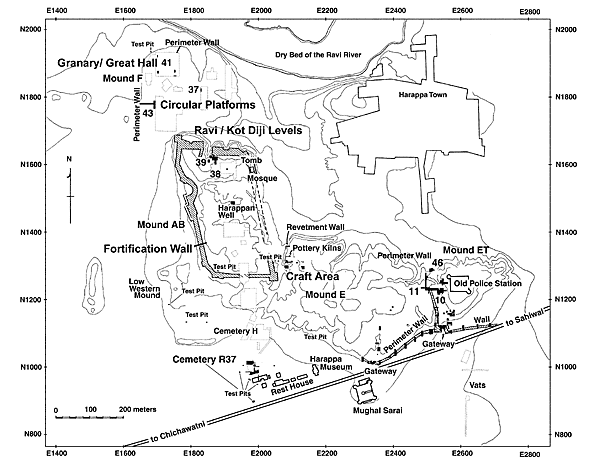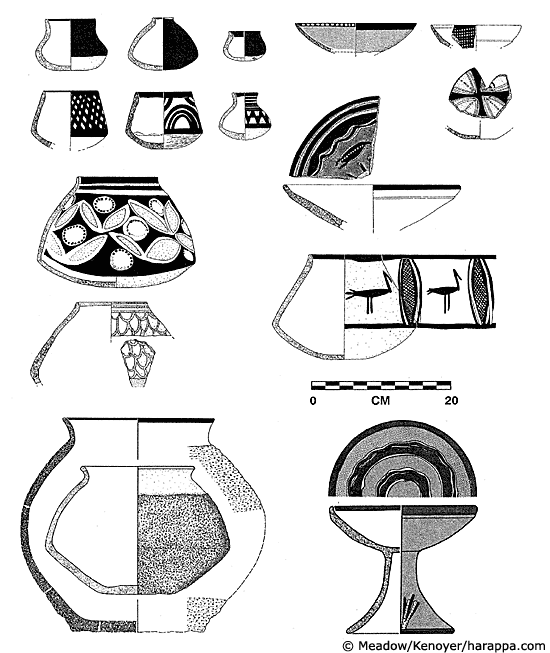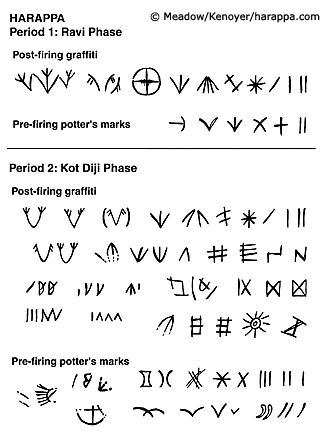Ravi Phase and Kot Diji Phase Occupations
On the northern part of Mound AB (Figure 1) excavations in 1996 were undertaken in both the Ravi (Hakra) Phase (Period 1: 3300-2800 BCE) and the Kot Diji Phase (Period 2: 2800-2600 BCE) occupation levels. In 1998 - 2000 a much larger horizontal exposure was made of both Ravi and Kot Diji levels. During the Ravi and Kot Diji Phases various aspects of settlement structure, specialized technologies, and socio-economic networks were developed and became the foundation for later urban structure of the Harappa Phase (Kenoyer and Meadow 1999).

Figure 1: Harappa Excavation Areas: 2000
The Ravi Phase village was probably divided into two parts, with one part along the northern edge of what is now Mound AB and the other at the northwest corner of Mound E, the two separated by a low-lying area (Figure 1). The earliest architectural structures appear to have been huts oriented north-south and east-west made of wooden posts with walls of plastered reeds. Some mud-brick fragments of what may be a kiln have been found, but no complete mud-brick architecture has been found to date.
The earliest pottery at Harappa (Period 1A) are entirely hand-built shapes with a range of decoration from plain to polychrome (Figure 2). Some vessels have a coarse appliquŽ on the exterior made from clay and calcium carbonate nodules. Towards the end of the Ravi Phase (Period 1B), the potter's wheel began to be used, resulting in new and diverse vessel forms and rim shapes. Some of these forms became the basis for the pottery of the Kot Diji Phase.

Figure 2. Ravi Phase Pottery
The use of pre-firing "potter's marks" and post-firing "graffiti" on pottery also indicates that concepts of graphic expression using abstract symbols were emerging (Figure 3). Many of the marks and signs consisted of a single character or symbol, but one example has three linked trident or plant shapes. Many of marks and signs used during the Ravi Phase continued to be employed through the Kot Diji Phase, and on into the Harappa Phase, where some of them can be identified as elements of the Indus writing system.

Figure 3. Post Firing Graffiti and Pre-Firing Potter's Marks
Kot Diji Phase Developments
The Kot Diji Phase was initially proposed as representing a phase of incipient urbanism, based on surveys conducted by Mughal (Mughal 1990). This interpretation can now be confirmed through excavations at Harappa (Meadow and Kenoyer 2001) and additional surveys in the hinterland around Harappa (Mughal, Iqbal et al. 1996). It is now clear that initial urban development in the Indus region began between approximately 2,800 and 2,600 BCE during the Kot Diji Phase (Harappa Period 2). The scale of urban networks is smaller than that characteristic of the Harappa Phase, but many of the basic characteristics of later Indus society are identifiable.
The total area of the Kot Diji settlement at Harappa is more than 25 hectares and covers most of Mound AB, Mound E and parts of Mound ET (Figure 1). Early city planning is reflected in the layout of north-south and east-west oriented streets and houses, and the use of mud-bricks of two sizes with 1:2:4 ratios to build houses, massive mud-brick platforms, and perimeter walls (Kenoyer 1993; Kenoyer 1995). In addition, the site was divided into two distinct mounds (AB and E) each with a massive mud-brick perimeter wall. During this period Harappa emerged as a major regional center, integrating its hinterland as well as obtaining materials from distant resource areas (Kenoyer 1997).
The wide variety of raw materials used in specialized crafts during the Kot Diji Phase indicates the continued expansion of trade networks that were initiated during the Ravi Phase. Marine shells were brought from more than 860 kilometers away for ornament manufacture. Various rocks and minerals were imported over distances of 300 to 1,000 kilometers for the production of utilitarian objects such as grinding stones and chipped stone tools as well for the manufacture of ornaments such as beads and inlay. The use of similar raw materials from different resource areas, such as grey black chert from Baluchistan and tan chert from Sindh, indicates a competitive expansion of trade networks and the increasing importance of exotic items.
Craft production indicators from Kot Diji levels show a marked increase in technological complexity and new types of finished objects. The production of glazed steatite beads and seals as well as of faience ornaments resulted from the refinement of earlier glazed steatite manufacturing techniques. Precious metals such as copper and gold were also employed for both utilitarian and decorative purposes. Many additional styles of bangles, beads, pottery and other utilitarian objects reveal the need for increased variety for a more diverse urban population (Kenoyer 2000).
While some hand-built containers continued to be made during Period 2, most pottery was made on the wheel and carefully trimmed, slipped, painted, or decorated with some sort of surface modification. Red slip and black painted designs replaced polychrome decorations of the Ravi Phase. The motifs include horizontal bands, new styles of geometric and floral motifs, as well as the more traditional pipal leaf, fish scale, and intersecting motifs that had their origins in the Ravi Phase.
The large collections of pottery from this area reveals a clear transition from the earlier Ravi pottery to what is commonly referred to as Kot Diji pottery. The later Kot Diji levels show a gradual transformation into what is commonly referred to as Harappa Phase pottery. When combined with the evidence of other artifact types, such as terracotta cakes, bangles, figurines and even architecture, it is possible to confirm that the Harappan culture emerged from the earlier Kot Diji culture and that it was not introduced to this area from outside regions.
Of particular importance in this regard is the first appearance of the Early Indus script that has been found on pottery, a sealing of a square seal with possible Early Indus script, and a cubical limestone weight that conforms to the later Harappan weight category. In 2000, a fragment of an unfinished square steatite seal carved with an elephant motif was discovered which indicates that this unique type of seal was being made in addition to the more common geometric button seals (Figure 4) (Meadow, Kenoyer and Wright 2000). These discoveries suggest that the development of the Indus script, the use of inscribed seals and the standardization of weights occurred during the Kot Diji period, some 200 years earlier than previously thought. The emergence of writing, seals and standardized weights also implies the development of more complex social and political organizations that would have required these sophisticated tools and techniques of communication and administration.
These new developments of site organization and specialized crafts appear to be linked to the emergence of a more highly differentiated society during the Kot Diji Phase. Possible forms of social elaboration include the development of hierarchies and occupational classes as well as the inclusion of new ethnic groups, including those not previously incorporated into the urban structure. Such groups may have comprised pastoralists, hunters, fishers, and those associated with many of the specialized crafts and long distance trade that became increasingly important during this period and the following Harappa Phase.
{Reprinted by permission from: Meadow, R.H. and J.M. Kenoyer (2001) Recent discoveries and highlights from excavations at Harappa: 1998-2000. INDO-KOKO-KENKYU [Indian Archaeological Studies] 22: 19-36.}
